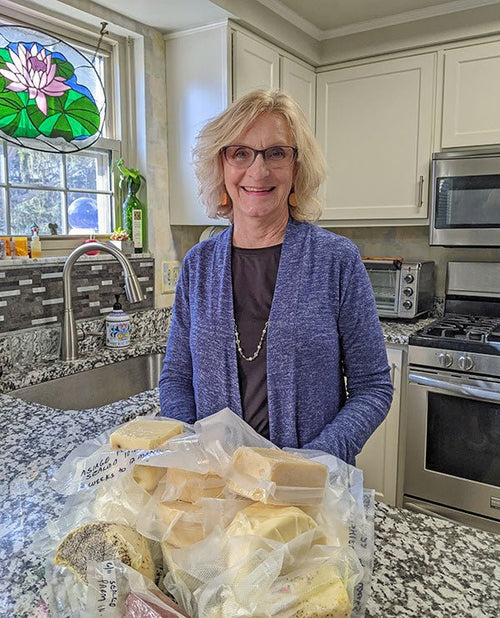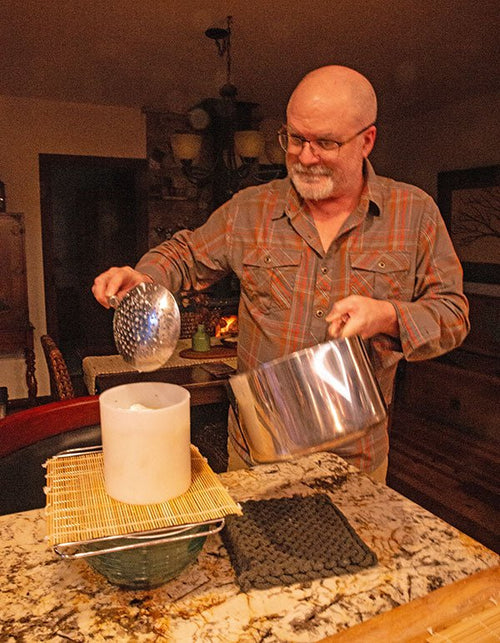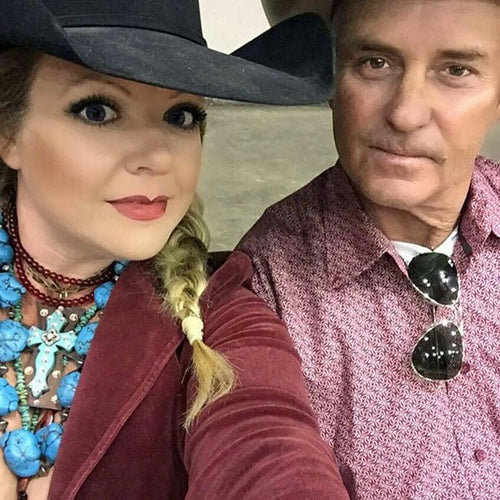Cheese Making Recipe of the Month
Quark
Quark is a fresh cheese that never gets heated beyond 86F. This means if you have a source for real milk, you get a sweet, creamy spreadable cheese with all the benefits of the good bacteria in the milk. In other words, it qualifies as raw food which is thought to be more nutritious and digestable than cooked food. (Of course, if you have pasteurized milk, you will still get a delicious cheese.)
Jim had never made or even tasted Quark until this month. He was totally amazed by the delightful taste and texture of this simple cheese. (In fact, he used a new word- fantabulous!)
Apparently the Europeans (especially the Germans) are eating this cheese in every possible way for breakfast, lunch and dinner. Who knew? Quark is also touted by many chefs to be the best cheese for cheesecake. By the way, if you have a good recipe for cheesecake made with Quark, please send it along with a picture to Moosletter@cheesemaking.com.
Making Cheese with Suzanne
Stirred-Curd Cheddar
Suzanne is truly amazing! She has proven again and again how easy it is to make cheese. This month she shares her new found expertise in making a stirred-curd cheddar, shown in all it's glory at right.
At the end of her article, when you see how she melted her cheese on her black bean burgers, you'll want to run right out and buy a farm! Of course, all you really need is the milk and a few ingredients. In fact, if you don't have all the supplies you need, try for her giveaway at Chickens in the Road.
It is actually amazing that Suzanne was able to make cheese at all this spring, because her farm was under so much mud that she wasn't even able to get to the barn to milk Beulah Petunia at times. Now, lately, the ground has been drying up and Suzanne is back in the milk business (where the mission, of course, is to save as much milk as possible by storing it as cheese.)
By the way, that's Suzanne way over on the left in the picture with Beulah Petunia. They're both kind of cute, don't you think?!
Non-Chlorinated Seltzer!
Non-Chlorinated Seltzer!
I was able to get my hands on some raw milk today, and knew I was going to be insanely busy the rest of the week, so I settled down to make a batch of mozzarella. (yum)
Pulled everything out, including the directions (it'd been a while) ... only to remember, I needed spring water. Well, I have very well chlorinated city water.
So, I pulled a bottle of seltzer off the shelf, shook out the bubbles, and used that.
Have to say, it worked a charm!
Just thought I'd share, who knows who else forgets that the water in their sink just isn't useful for cheese!
Donna Hendry
Beautiful Wax Jars on the Shelf
I thought this a clever idea when waxing cheese! I cut off chunks, and place them in a large widemouth ball jar. Then I put the jar into a saucepan of boiling hot water and let it simmer until the wax is melted.
I can brush (or slowly pour) to coat the cheese easily, not to mention the mess is contained in the jar. Add to that the fire safety--I can screw on a lid JUST in case! When through, the jar is pulled from the bath, left to cool (solidify), re-capped and stored in the pantry for future cheeses. The brush, if short enough, can go in the jar, too!
I want to point out, as with canning, one must be careful, as even glass canning jars are fragile and can break. I would NOT suggest using an old commercial candle jar, as their wax is scented and could taint the cheese wax.
I did find it very useful and cleanup as easy as screwing on a lid! Keeping the different colored waxes in their own jar, as opposed to having and storing a pan for each makes it worthy of consideration. Not to mention, the beauty of displaying them openly on a shelf in a country kitchen identifies one as a cheese maker.
Kathy Schweitzer
Making Yogurt Once Every 48 Days!
I thought I would pass on my procedure for making larger quantities of yogurt. After experiencing the time considerations in making a weeks supply of yogurt, I started to experiment with larger quantities using pint mason jars with canning lids and incubating them in crock pot water baths - first 4 jar quantities in one pot then 8 jar quantities in two pots.
I am the sole consumer of yogurt and make a pint jar last 3 days. The rest were stored in the refrigerator for the following 23 days. After using this procedure for at least five occasions without any sign of spoilage or reduction in quality, I got the notion to expand production.
I bought a 10 quart stainless steel stock pot, a Classic APN/ Wycoff electric steam tray with adjustable temperature control and a stainless steel raised mesh insert to fit inside the steam tray from a culinary trade supply store. The tray holds 16 pint mason jars with the capability of controlling the water bath temperature at 116 F to the neck of the jars. I have used this procedure over twelve times, providing a 48 day refrigerated supply and have never experienced any indication of spoilage or quality reduction. Once the technique is established, there is not a lot of difference in production and clean up time from a 4 jar production. I average an hour and 45 min from start to finish. I do incubate the jars for 6 hours, however.
I have used the yogurt formula from your book using the low fat option: a gallon of quality skim milk, a gallon of powdered milk, one container of Greek yogurt and two packets of gelatin. All equipment is steam cleaned and the jars are sanitized in a food grade bucket containing a solution of the Star Acid Sanitizer. The cost outlay of the stock pot and the steam tray can be a bit expensive; however, they too have other uses in the kitchen. I had been using the metal canning lids but am now switching to the plastic mason jar lids.
Anne Davis
Cojack
I wanted to try to make that interesting concoction sold in stores as "CoJack cheese" with the white Monterey jack pieces intermixed with the orange colby in one cheese. You know the stuff.
At first, it seemed beyond the scope of the home cheese maker, but the timing of the recipes for Colby and Monterey Jack in your cheese making book Home Cheese Making isn't all that far apart, and with 2 pots, a double bowl kitchen sink and a little scurrying, I was able to mix up a one gallon batch of each, mix the curds together, and satisfactorily press the whole thing into one cheese that looks just like the stuff you buy in the store.
I aged it about 8 weeks total. I think I probably should have air dried it for a few more days before waxing it. It's good, it melt's fairly well on nachos, and the taste is right, but I think I'll get a little bit better texture if I let it dry a few more days next time.
Brad Mellor
That Mysterious Skyr
I've been on the hunt for some Skyr. So far I've had very little luck and was wondering if you have any cultures or know of any sources. The thing is that the Skyr bacteria is hard to come by. I've planned on buying some Skyr style yogurt and making my own mother and using that for my starter. If anyone has access to something a bit more traditional, I'd love to hear from them.
Larkin Young
We Love This Book! -The Joy of Cheesemaking
By Jody M. Farnham and Marc Druart, 2011
They call this "The Ultimate Guide" and it really is. No detail has been left unexamined. It includes color pictures, illustrations, charts, recipes, and a full glossary.
There is an explanation of the basic chemistry involved in the cheese making process and there are complete descriptions of methods for molding, pressing, aging, etc. There are tours of artisan cheese farms and there are even suggestions for wine and beer pairings with cheese.
This book is slightly more advanced than our own- Home Cheese Making, so we are selling it in a special Home Cheese Making Book Set - both together for $25. (We are also selling them separately, of course.)
Here's the Scoop!
Finally we have a scoop that fits your molds and doesn't get curds all over the place! They slide ever so easily from the points of the triangular sides into whatever containers you are using.
We actually have this scoop in 2 different colors because we couldn't decide which one we liked better. So, you can make a choice between black or orange. Either way, your curdy mess is over!
Please send your cheese making news & photos to: moosletter@cheesemaking.com












































































































































